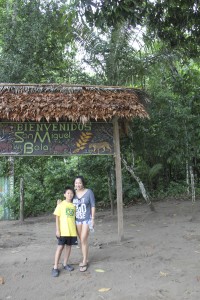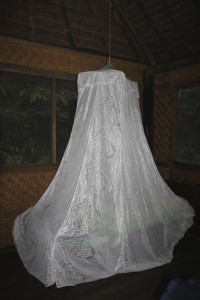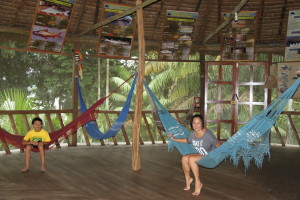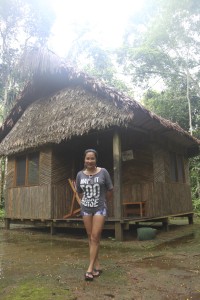Dec. 7/12 – The Amazon covers 2.5 million square miles, embracing nine countries in South America, roughly two thirds of the continent. Its name comes from the Amazon River, born in the highlands of Peru and fed by 1,100 tributaries along its 4,000 mile length before discharging in the Atlantic Ocean.
Among those 9 countries, Bolivia offers the least expensive way to enter and visit the Amazon so I figured that since we were already here, it would be a good experience for us to check it out. We joined a jungle tour for 3 days which was 2 days too many for me despite the fact we were being treated like VIP with a canoe operator assigned particularly for us, a personal chef who makes excellent food, personal cleaning maid and a personal guide. We were very fortunate that since it is low season, there were only the 2 of us in this group and so we were given the services usually extended to those who booked for private trips. This was very welcome, indeed.
What is not very welcome were the 66 mosquito bites despite the tons of mosquito repellant creams and wipes I put on already. Then, there was the weather that was 32 – 36 degrees high plus what felt like 102% humidity!! I feel that after this jungle trip, I am ready to try camping out on a tent but will never ever choose to camp in a jungle . I will take a desert before I will take a jungle! I am officially DONE with visiting anymore RAINFOREST ever!!
Now, back to our experience. To get to the jungle, we needed to first fly 40 mins on a tiny 20-seater plane from La Paz to the small city called Rurrenabaque, then take an hour ride on a motorized canoe to get the jungle where we would be staying the first night only then another 2 hour boat ride to a different lodge in Madidi National Park after that first night. After settling into the cute little Eco-lodge, we went to visit 1 of the 27 local communities that lives in the jungles (each community has a range of 200 to 700 people) and see how the Indigenas (native) people live.
It was only a 20-minute hike from where our lodge was but by the time I got to the San Miguel del Bala Community to see how the Indigenas are living, I felt like I just travelled on a “time machine” going back a hundred years or at least back to the time of Tarzan. One to three families shared a simple hut the size of no more than 80-120 sq ft, just an open space, with no dividers at all. There was no hot water, no plumbing, no electric, no TV, no phone, no internet, but simple kitchen and washroom which are located outside and to be shared by everyone. The good thing is that they don’t have need for money because they grow their own fruits, vegetables, and rice and they raise their owns chicken and pigs. There is no where to spend money on actually and some of them have never left the jungle all their lives. Men and boys go to fishing while the women and girls do the farming and cooking. They barter if necessary. What’s amazing is all the smiles I saw on the people’s face here. I finally understood what “innocent is bliss” means. Life just seemed very simple and they seem very content. I wish I could speak their language so I could talk to them more. As much as I admired their simplicity, I couldn’t stop feeling grateful for the kind of life I have. I couldn’t stop appreciating how much mankind has achieved and how much the world has evolved over the years now that I have the comparison glaring at me, up close and personal.
Afterwards, I had a long talk with Deon over dinner about life in a jungle versus life in the modern city. Then he said, “Yeah, some people say the city people are relying on technology too much.” And then with a smile, he said, “But I am quite OK to keep on “relying” in this area.” lol
Even though we didn’t see any monkeys because we couldn’t handle walking 4 more hours in the HOT and HUMID weather (a deadly combination for Amy and Deon) to get to where they were, we managed to see lots of butterflies, birds, spiders, many different insects and wild flowers in the jungle. We experienced extreme weather changes from hour to hour here. It was pouring rain, then an hour later it was the bright sun glaring down at us then back to rain again. Lying on the indoor hammock while listening to the sound of the rain bouncing into the trees and the straw roof on the hut was very soothing to me. This time, the rain came to me as “sound” whereas the Vancouver rain comes to me as “noise.”
But the best part about this 3 day trip was the amount of organic fruits we ate every other hour. I had the best papaya, mango and pineapple ever, even better than the ones I ate in Thailand & the Philippines. We ate enough fruits over the last 3 days to make up for its lack the last 10 weeks!
Three days of connecting to nature was enough for me. I was really happy to be back to the city connecting to family and friends via emails and FB now. Haha. Our next stop is a visit to the last city in Bolivia called Copacabana to see the world’s highest lake, Lake Titikaka.
I am excited to see how the water of this lake changes colors and how the Indigenas people live on floating homes there.
Originally posted on Amy’s travel blog: TravelwithAmy.ca









